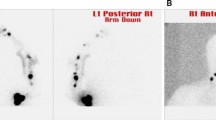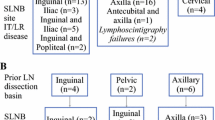Abstract
Background
We analyzed the outcomes and factors associated with false-negative (FN) results of sentinel lymph node (SLN) biopsy findings in patients with cutaneous melanoma. SLN biopsy failure rate was defined as nodal recurrence in the biopsied regional basin without previous local or in-transit recurrence.
Methods
Between April 1997 and December 2004, a total of 1207 patients with cutaneous melanoma with a median Breslow thickness of 2.4 mm underwent SLN biopsy by preoperative and intraoperative lymphoscintigraphy combined with dye injection. In 228 cases, we found positive SLNs; of these, 220 underwent completion lymph node dissection (CLND). Median follow-up was 3 years.
Results
The SLN biopsy failure rate was 5.8% (57 of 979 SLN negative). Median time to occurrence of FN relapse after SLN biopsy was 16 months (range, 3–74 months). The FN SLN biopsy results correlated with primary tumor thickness >4 mm (P = .0012), primary tumor ulceration (P = .0002), primary tumor level of invasion Clark stage IV/V (P = .0005), and nodular melanoma histological type (P = .0375). Five-year overall survival, calculated from the date of primary tumor excision, in the FN group was 53.7%, which was not statistically significantly worse than the CLND group (56.8%; P = .9). The FN group was characterized by a higher ratio of two or more metastatic nodes and extracapsular involvement of lymph nodes after LND compared with the CLND group (P < .0001 and P < .0001, respectively). Additional detailed pathological review of FN SLN revealed metastatic disease in 14 patients, which decreased the SLN biopsy failure rate to 4.4% (43 of 979).
Conclusions
Survival of patients with FN results of SLN biopsy does not differ statistically significantly from that of patients undergoing CLND, although it is slightly lower. The SLN biopsy failure rate is approximately 5.0% in long-term follow-up and is associated mainly with the same factors that indicate a poor prognosis in primary melanoma.



Similar content being viewed by others
References
Morton DL, Wen DR, Wong JH, et al. Technical details of intraoperative lymphatic mapping for early stage melanoma. Arch Surg 1992; 127:392–9
Gershenwald JE, Thompson W, Mansfield PF, et al. Multi-institutional melanoma lymphatic mapping experience: the prognostic value of sentinel lymph node status in 612 stage I or II melanoma patients. J Clin Oncol 1999; 17:976–83
Statius Muller MG, van Leeuwen PA, de Lange-De Klerk ES, et al. The sentinel lymph node status is an important factor for predicting clinical outcome in patients with stage I or II cutaneous melanoma. Cancer 2001; 91:2401–8
Cascinelli N. WHO declares lymphatic mapping to be standard of care for melanoma. Oncology 1999; 13:288
Cascinelli N, Belli F, Santinami M, et al. Sentinel lymph node biopsy in cutaneous melanoma: the WHO Melanoma Program experience. Ann Surg Oncol 2000; 7:469–74
Balch Ch M, Buzaid AC, Soong SJ, et al. Final version of the American Joint Committee on Cancer staging system for cutaneous melanoma. J Clin Oncol 2001; 19:3635–48
Morton DL, Thompson JF, Essner R, et al. Validation of the accuracy of intraoperative lymphatic mapping and sentinel lymphadenectomy for early-stage melanoma—a multicenter trial. Ann Surg 1999; 4:453–65
Morton DL, Thompson JF, Cochran AJ, Essner R, Elashoff R. Interim results of the Multicenter Selective Lymphadenectomy Trial (MSLT-I) in clinical stage I melanoma (abstract 7500). J Clin Oncol 2005; 23(suppl):710s
Nowecki ZI, Rutkowski P, Nasierowska-Guttmejer A, Ruka W. Sentinel lymph node biopsy in clinically N0 melanoma patients—one institution experience. Melanoma Res 2003; 13:35–43
Cook MG, Green Ma, Anderson B, et al. The development of optimal assessment of sentinel lymph nodes for melanoma. J Pathol 2003; 200:314–9
McMasters KM, Reintgen DS, Ross MI, et al. Sentinel lymph node biopsy for melanoma: controversy despite widespread agreement. J Clin Oncol 2001; 19:2851–5
Morton D, Chan A. Current status of intraoperative lymphatic mapping and sentinel lymphadenectomy for melanoma: is it standard of care? J Am Coll Surg 1999; 189:214–23
Fincher TR, McCarthy TM, Fischer TL, et al. Patterns of recurrence after sentinel lymph node biopsy for cutaneous melanoma. Am J Surg 2003; 186:675–81
Wagner JD, Ranieri J, Evdokimow DZ, et al. Patterns of initial recurrence and prognosis after sentinel lymph node biopsy and selective lymphadenectomy for melanoma. Plast Reconstr Surg 2003; 112:486–97
Gershenwald JE, Colome MI, Lee JE, et al. Patterns of recurrence following a negative sentinel node biopsy in 243 patients with stage I or II melanoma. J Clin Oncol 1998; 16:2253–60
Clary BM, Mann B, Brady MS, Lewis JL, Coit DG. Early recurrence after lymphatic mapping and sentinel node biopsy with primary extremity melanoma: a comparison with elective lymph node dissection. Ann Surg Oncol 2001; 8:328–37
Jacobs IA, Chevinsky AH, Swayne LC, Magidson JG, Britto EJ, Smith TJ. Gamma probe-directed lymphatic mapping and sentinel lymphadenectomy in primary melanoma: reliability of the procedure and analysis of failures after long-term follow-up. J Surg Oncol 2001; 77:157–64
Statius Muller MG, Borgenstein PJ, Pipjers R, et al. Reliability of the sentinel node procedure in melanoma patients: analysis of failures after long-term follow-up. Ann Surg Oncol 2000; 7:461–8
Vuylsteke RJCLM, van Leeuwen PAM, Statius Muller MG, Gietema HA, Kragt DR, Meijer S. Clinical outcome of stage I/II melanoma patients after selective lymph node dissection: long term follow-up results. J Clin Oncol 2003; 21:1057–65
Gadd MA, Cosimi AB, Yu J, et al. Outcome of patients with melanoma and histologically negative sentinel lymph nodes. Arch Surg 1999; 134:381–7
Chao C, Wong SL, Ross MI, et al. Patterns of recurrence after sentinel lymph node biopsy for melanoma. Am J Surg 2002; 184:520–5
Statius-Mueller MG, van Leeuwen PA, Van Diest PJ, et al. Pattern and incidence of the first site recurrences following sentinel node procedure in melanoma patients. World J Surg 2002; 26:1405–11
Duprat JP, Silva DC, Coimbra FJ, et al. Sentinel lymph node biopsy in cutaneous melanoma: analysis of 240 consecutive cases. Plast Reconstr Surg 2005; 115:1944–51; discussion 1952–3
Jansen L, Nieweg OE, Peterse JL, Hoefnagel CA, Olmos RA, Kroon BB. Reliability of sentinel lymph node biopsy for staging melanoma. Br J Surg 2000; 87:484–9
Estourgie SH, Nieweg OE, Valdes Olmos RA, Hoefnagel CA, Kroon BB. Review and evaluation of sentinel node procedures in 250 melanoma patients with median follow-up of 6 years. Ann Surg Oncol 2003; 10:681–8
Yee VS, Thompson JF, McKinnon JG, et al. Outcome in 846 cutaneous melanoma patients from a single center after a negative sentinel node biopsy. Ann Surg Oncol 2005; 12:429–39
Doting MHE, Hoekstra HJ, Plukker JThM, et al. Is sentinel node biopsy beneficial in melanoma patients? A report on 200 patients with cutaneous melanoma. Eur J Surg Oncol 2002; 28:673–678
Scolyer RA, Thompson JF, Li LX, et al. Failure to remove true sentinel nodes can cause failure of the sentinel node biopsy technique: evidence from antimony concentrations in false-negative sentinel nodes from melanoma patients. Ann Surg Oncol 2004; 11(3 suppl):174S–8S
Stewart LE, Tyler DS, Vollmer RT. The importance of total number of sentinel lymph nodes in patients with stage N0 cutaneous melanoma. Am J Clin Pathol 2005; 124:77–82
Porter G, Ross MI, Berman RS, et al. How many lymph nodes are enough during sentinel lymphadenectomy for primary melanoma? Surgery 2000; 128:306–11
Gershenwald JE, Mansfield PF, Lee JF, Ross MI. Role for lymphatic mapping an sentinel lymph node biopsy in patients with thick (≥4 mm) primary melanoma. Ann Surg Oncol 2000; 7:160–5
Pawlik TM, Ross MI, Thompson JF, Eggermont AMM, Gershenwald JE. The risk of in-transit melanoma metastasis depends on tumor biology and not the surgical approach to regional lymph nodes. J Clin Oncol 2005; 23:4588–90
Rutkowski P, Nowecki ZI, Zurawski Z, et al. In-transit/local recurrences in melanoma patients after sentinel node biopsy and therapeutic lymph node dissection. Eur J Cancer 2006; 42:159–64
Pawlik TM, Ross MI, Johnson MM, et al. Predictors and natural history of in-transit melanoma after sentinel lymphadenectomy. Ann Surg Oncol 2005; 12:587–96
Niakosari F, Kahn HJ, Marks A, From L. Detection of lymphatic invasion in primary melanoma with monoclonal antibody D2-40: a selective immunohistochemical marker of lymphatic endothelium. Arch Dermatol 2005; 141:440–4
van Akkooi ACJ, de Wilt JHW, Verhoef C, et al. High positive sentinel node identification rate by EORTC Melanoma Group protocol: prognostic indicators of metastatic patterns after sentinel node biopsy in melanoma. Eur J Cancer 2006; 42:372–80
Li LX, Scolyer RA, Ka VS, et al. Pathologic review of negative sentinel lymph nodes in melanoma patients with regional recurrence: a clinicopathologic study of 1152 patients undergoing sentinel lymph node biopsy. Am J Surg Pathol 2003; 27:1197–202
Starz H. Pathology of the sentinel lymph node in melanoma. Semin Oncol 2004; 31:357–62
Roberts AA, Cochran AJ. Pathologic analysis of sentinel lymph nodes in melanoma patients: current and future trends. J Surg Oncol 2004; 85:152–61
Ruiter DJ, Spatz A, van der Oord JJ, Cook MG. Pathologic staging of melanoma. Semin Oncol 2002; 29:370–81
Cochran AJ, Balda BR, Starz H, et al. The Augsburg Consensus—techniques of lymphatic mapping, sentinel lymphadenectomy and completion lymphadenectomy in cutaneous malignancies. Cancer 2000; 89:236–41
Kuo CT, Hoon DS, Takeuchi H, et al. Prediction of disease outcome in melanoma patients by molecular analysis of paraffin-embedded sentinel lymph nodes. J Clin Oncol 2003; 21:3566–72
Li W, Stall A, Shivers SC, Lin et al. Clinical relevance of molecular staging for melanoma: comparison of RT-PCR and immunohistochemistry staining in sentinel lymph nodes of patients with melanoma. Ann Surg 2000; 231:795–803
Sung J, Wenbin L, Shivers S, Reintgen D. Molecular analysis in evaluating the sentinel node in malignant melanoma. Ann Surg Oncol 2001; 8(9 suppl):29–30
Cochrane AJ, Wen D-R, Morton DL. Occult tumor cells in the lymph nodes of patients with pathological stage I malignant melanoma: an immunohistochemical study. Am Surg Pathol 1988; 12:612–8
Cochran AJ, Huang RR, Guo J, Wen D-R. Current practice and future directions in pathology and laboratory evaluation in the sentinel node. Ann Surg Oncol 2001; 8(suppl):13–7
McMasters KM, Noyes RD, Reintgen DS, et al. Lessons learned from the Sunbelt Melanoma Trial. J Surg Oncol 2004; 86:212–23
Shen J, Wallace AM, Bouvet M. The role of sentinel lymph node biopsy for melanoma. Semin Oncol 2002; 29:341–52
Acknowledgments
We thank M. Rosinska, MD, for statistical advice and M. Symonides, MD, PhD, for English-language assistance.
Author information
Authors and Affiliations
Corresponding author
Additional information
Preliminary results of this study were presented as an oral presentation during the Melanoma Session on the 59th Annual Cancer Symposium of the Society of Surgical Oncology, San Diego, CA, March 23–25, 2006.
Rights and permissions
About this article
Cite this article
Nowecki, Z.I., Rutkowski, P., Nasierowska-Guttmejer, A. et al. Survival Analysis and Clinicopathological Factors Associated With False-Negative Sentinel Lymph Node Biopsy Findings in Patients with Cutaneous Melanoma. Ann Surg Oncol 13, 1655–1663 (2006). https://doi.org/10.1245/s10434-006-9066-0
Received:
Revised:
Accepted:
Published:
Issue Date:
DOI: https://doi.org/10.1245/s10434-006-9066-0




